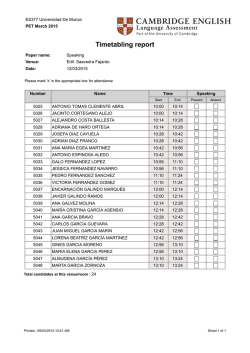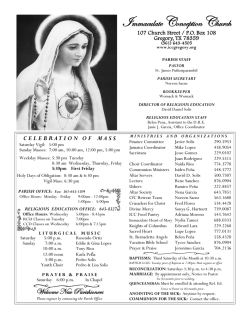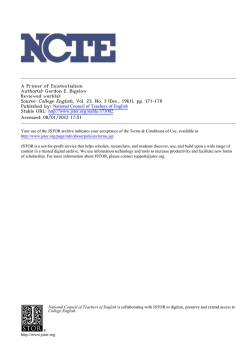
Alberto Flores Galindo. In Search of an Inca.
In Search of an Inca edited by Alberto Flores Galindo, Carlos Aguirre, Charles F. Walker, and Willie Hiatt In Search of an Inca by Alberto Flores Galindo; Carlos Aguirre; Charles F. Walker; Willie Hiatt Review by: Barbara Celarent American Journal of Sociology, Vol. 120, No. 1 (July 2014), pp. 306-311 Published by: The University of Chicago Press Stable URL: http://www.jstor.org/stable/10.1086/679517 . Accessed: 24/02/2015 15:33 Your use of the JSTOR archive indicates your acceptance of the Terms & Conditions of Use, available at . http://www.jstor.org/page/info/about/policies/terms.jsp . JSTOR is a not-for-profit service that helps scholars, researchers, and students discover, use, and build upon a wide range of content in a trusted digital archive. We use information technology and tools to increase productivity and facilitate new forms of scholarship. For more information about JSTOR, please contact [email protected]. . The University of Chicago Press is collaborating with JSTOR to digitize, preserve and extend access to American Journal of Sociology. http://www.jstor.org This content downloaded from 128.135.12.127 on Tue, 24 Feb 2015 15:33:20 PM All use subject to JSTOR Terms and Conditions American Journal of Sociology aspora leadership and the variety of entrepreneurship ðin homeland movements as well as in the diaspora organizationsÞ could also be explored further. Assessing the degree of integration into the United States, the nexus of ðinterÞorganizational activity ðrise and declineÞ, the nature of attachments, and the character of community organization—for instance the effects of the ethnic bonding and bridging of social capital—may provide further insights with regards to attachment or detachment to national causes. Sinews of the Nation is an excellent book that highlights the significant role of economic transactions in nation building through a comparative approach. A main contribution is the emphasis on the active processes associated with nation building, its organization, and its mobilization, that identify monetary transactions and fundraising campaigns as one significant process during which attachment to nations and communities are nurtured and fostered. In Search of an Inca by Alberto Flores Galindo. Edited and Translated by Carlos Aguirre, Charles F. Walker, and Willie Hiatt. Cambridge: Cambridge University Press, 2010. Pp. xxix1270. Barbara Celarent* University of Atlantis In the metropolis, the late 20th century was a time of connection and convergence. There were melting pots and migratory labor, world capitalism and international organizations. In the face of these centripetal forces, there were also attempts to preserve difference: multiculturalism, “rainbows,” and other such movements. But these usually remained within the limits of the homogeneous consumer capitalism of that time. Outside the metropolis, to be sure, there was no need for reminders about difference. The power of the center provided harsh reminders continuously. Yet even in the metropolis, difference flourished. To be sure, national difference had to some extent subsided after the terrors of 1914–45. But racial difference evolved toward new complexities under the pressure of immigration; religious difference perplexed the secularists with one of its periodic revivals; and new solidarities like gender and age swirled into the mixture. We finish the year with a work that aims to create—or recreate—such difference: In Search of an Inca by Alberto Flores Galindo. Flores Galindo was born in Peru in 1949, the son of a lawyer. His interest in history dated from his primary and secondary studies at the Colegio La Salle and was confirmed by his university studies at the Ponitificia Universidad Catolica. A trip to a mining camp in 1971 led to his bachelor’s thesis, later published as Los Mineros de la Cerro de Pasco, 1900–1930. In 1972–74 he studied at * Another review from 2053 to share with AJS readers.—Ed. 306 This content downloaded from 128.135.12.127 on Tue, 24 Feb 2015 15:33:20 PM All use subject to JSTOR Terms and Conditions Book Reviews the École des Hautes Études en Sciences Sociales, a trans-Paris graduate school of history and social science, then the center of the Annales School of history. Encouraged by leaders of the École, including Pierre Vilar and Fernand Braudel, he did his doctoral studies under Ruggiero Romano of the University of Paris at Nanterre. Eventually accepted in 1984, the thesis was published as Aristocracia y plebe en Lima, 1760–1830. A second edition was retitled as La ciudad sumergida. The change was no surprise. Flores Galindo had been active in left student groups in both Peru and Paris, and his strong support for dominated populations took shape in a newly written section on Andean populations as another of the submerged groups in 18th- and 19th- century Lima. On his return to Peru in 1974, Flores Galindo became professor of sociology in the social science department of his alma mater, the Pontificia Universidad Católica. He threw himself into Peruvian intellectual life. He ran congresses, edited journals, published academic papers and books in quick succession, and wrote extensively for the popular press. He also supervised students (BA theses are often cited in Search) and initiated numerous new research projects, all the while finishing his own doctoral studies, marrying, and raising a family. Throughout the 1980s he evolved the “Andean utopia” concept, culminating in 1986 in the first version of the book we read here. But then he was suddenly stricken with brain cancer and died in March 1990. Although it has extensive footnotes, In Search of an Inca is at heart a political intervention, addressed to an intensely local audience of intellectuals. It cites sources and debates only insiders can know, and it takes for granted a broad command of Peruvian history. It does little to compare the Peruvian case with others, and when it does so, it cites the Peruvian view of those cases. Thus, Brazil’s Canudos rebellion appears through the eyes of Mario Vargas Llosa’s novel (Guerra del fin del mundo) rather than Euclides da Cunha’s earlier nonfiction masterpiece (Os sertões). Flores Galindo’s central concern is to reinterpret crucial moments and themes in Peruvian history, bringing together a set of ideas, symbols, and stories that he molds into the concept of “Andean utopia.” This concept is introduced in the work’s opening pages, and on first reading one expects a book in the tradition of Johan Huizinga’s Waning of the Middle Ages or Michel Foucault’s Madness and Civilization: an evocation of a pervasive but hidden cultural current that others have missed. But Flores Galindo is not simply evoking the Andean utopia, he is also espousing it. He does see its flaws, and he does realize that it must be reinvented. But the Andean utopia is for him truly utopian: an ideal to be recreated in a new form. His central audience is not the wider scholarly community, but the local political and intellectual one. And if the book has been read by many scholars from other countries, it has been read precisely for this combination of articulate and often self-critical scholarship with a political commitment that is itself subtle and self-reflective. Few have merged research and passion so well. The book comprises a series of snapshots, chronologically ordered and linked by the common theme of Andean utopia. The first chapter addresses 307 This content downloaded from 128.135.12.127 on Tue, 24 Feb 2015 15:33:20 PM All use subject to JSTOR Terms and Conditions American Journal of Sociology the original European occupation as lived and construed by those Andean peoples who survived the holocaust of disease brought by the conquerors. The second chapter concerns the Catholic church’s attempts to stabilize conversion and suppress idolatry. Chapters 3 and 4 address two rebellions of the 18th century: those of Juan Santos Atahualpa in the 1740s and of Tupac Amaru in 1780. There follow three short chapters: chapter 5 on the governing projects of the Spanish rulers and of the rebellious Andean peoples; chapter 6 on the highlands during the period of independence; and chapter 7 on concepts of race as they evolved in the 19th century. The long chapter 8 looks at three basic aspects of 20th-century Peruvian history: the pro-indigenista movement, the populist Alianza Popular Revolucionaria Americana (APRA) of Raúl Haya de la Torre, and the indigenous socialism of José Carlos Mariátegui. Although mainly a study of Mariátegui, the chapter uses his work to understand the others and comments in passing on various minor rebellions and other historical events. Chapter 9 is both the crowning moment of the book and its most controversial. It first frames its argument as a comment on the writer José María Arguedas, then follows with a quick recitation of the vicissitudes of Peruvian politics in the years after 1960. But at its core is the position that the organization Shining Path (terrorist or emancipatory, depending on one’s politics) was in fact yet another expression of the Andean utopia. This claim is elaborated in chapter 10, which asserts that the Peruvian state was more terrorist than Shining Path and that even the extreme violence of Shining Path came from the same lineage of Andean utopia that had produced the earlier rebellions. By this unexpected conclusion Flores Galindo makes the conception of Andean utopia come suddenly and disturbingly alive. Earlier in the book, we have gradually built up a sense of Andean utopia as a fascinating, elusive cantus firmus of history: not quite a millenarian fantasy, but something beautiful and enduring, if nonetheless alien to the modern sensibility. We have seen that the phrase captures a kind of faint historical memory—unwritten outside the hearts of the andinos—of an Andean civilization comparable to those of Mesopotamia, Egypt, India, or China. For Flores Galindo, the recurrent use of Inca symbolism in Peruvian life—in open rebellions, in indigenous socialist theories, in clandestine violent movements, even occasionally by the colonialists themselves —evokes less the Inca rule in particular than this more general Andean civilization, whose memory was in part overwritten by the Incan expansion and in part destroyed by the Spaniards’ attack on the artifacts of Incan civilization and in particular on the quipus (and their interpreters, the quipucamayoc) through which and through whom the Inca empire and other Andean groups had kept their historical records. This Andean utopia is an imagined world of peaceful communalism, of rural socialisms tied together into an egalitarian and just empire that preserves difference even as it mobilizes the labor necessary for the public goods—such as roads and storehouses—so necessary in a physical environment much less welcoming than the valleys of the Nile, the Tigris/Euphrates, the Indus, or the Chang Jiang. 308 This content downloaded from 128.135.12.127 on Tue, 24 Feb 2015 15:33:20 PM All use subject to JSTOR Terms and Conditions Book Reviews But by interpreting Shining Path as yet another expression of the utopian impulse derived from the faint memory of this Andean past, Flores Galindo suddenly inverts our assumptions. For many or even most of his peers, Shining Path was a terrorist organization—arbitrary, brutal, violent. To make it part of the tradition of Andean utopia was suddenly to turn the reader from spectator to participant. One had to take sides. The debate Flores Galindo enters by this inversion is centuries old: the debate over the justness of the Inca and Spanish empires. The Andean archeological record speaks of a sophisticated civilization or civilizations before the Incas, and the Incas themselves seem to have suppressed the history of their predecessors to some extent. The succeeding Spanish colonial power then wrote Inca history largely on its own propagandist basis. But within the first century of the Spanish conquest, two opposing traditions had emerged. For writers like Pedro de Cieza de León and Pedro Sarmiento de Gamboa, the Incas were tyrannical conquerors and the andinos were primitives in need of Spanish tutelage and organization. For such others as Juan de Betanzos and Garcilaso de la Vega (both of whom had family connections to the Inca royal house), the Incas were, in the words of Flores Galindo, “the Romans of the new world,” who had found “only hordes and scattered chiefdoms” and “imposed a sense of organization” (p. 30). Of course the debate would have been just as profound at the moment of the Inca and Spanish conquests themselves had there been salaried professors to have such debates. The work of Bartolomé de las Casas remains to remind us of that. It is not pastness that makes this debate, but rather the present conflicts between the values represented by the various sides. There is no scientific politics—only the empirical reality of humans disagreeing, fighting, killing. And at the last, it seems that the project of humanely understanding all sides in such a debate is a hopeless business, for such an understanding prevents the decisive moral judgment that alone can move through and beyond such a conflict. Understanding may be the necessary preliminary, but it proves fatal to action. Perhaps one can take from such a debate only the will to understand more deeply and the confidence that understanding must in the end triumph, not so much in these insoluble past debates, but in those of our own times. Difference need not mean death. In Search of an Inca is thus simultaneously beautiful and disturbing. The invitation to exoticism is beguiling, for Flores Galindo was a profound romantic and his story is lovingly researched and brilliantly told. But the reader who surrenders to it will eventually find herself in frightening company and will reread the earlier chapters with a new eye. The more so, perhaps, given the technologies of terror and terror suppression that emerged shortly after Flores Galindo’s death. The debate is never far away, but always close at hand. Taken together, the texts of this year make a discordant ensemble. The striking uniqueness of each writer is easily stated, although in each case that uniqueness involves a surprising contradiction. Senghor writes social theory, but in a mode of lyrical effusion. Saffioti writes as a woman, about women, for women, but mixes sociologies later seen as opposed and even as anti309 This content downloaded from 128.135.12.127 on Tue, 24 Feb 2015 15:33:20 PM All use subject to JSTOR Terms and Conditions American Journal of Sociology feminist. Husayn comments on a great and ancient text, but comments sometimes as a Westernized scholar and other times as a devout Muslim. Fukuzawa writes of the society of enlightenment, but ends by showing us— unintentionally but effectively—the disturbingly close link between liberal enlightenment and ethnocentric nationalism. Flores Galindo shows us the flickering afterlives of a great idea, but then suggests they may not be afterlives but way stations to a dubious present. Germani writes mainstream social science, but does so always as an exile, a passionate outsider. Yet these very disparate writers have at the same time some perplexing similarities and connections. These can involve something as simple as age and cohort. We read young work by Saffioti, Husayn, and Flores Galindo: doctoral dissertations in the first two cases, an early collection in the third. These books are confident and clear, sometimes even brash. By contrast we read midcareer work from Senghor and Fukuzawa; in both cases the work is more conflicted and sober than the work of younger people. Yet the end-ofcareer book by Germani, although in some ways highly detached, still retains the hopefulness of an old exile who dreams of return. As the case of Germani suggests, too, it matters whether we have later works and lives to contextualize what we have read. Flores Galindo and Germani died immediately after writing the works we read, while Senghor and Husayn lived a half-century or more and Saffioti and Fukuzawa nearly as long. For the latter four, we inevitably interpret the texts of youth in terms of their later lives. Public life played an important but diverse role for these authors. Popularization dominated Fukuzawa’s career as to a lesser extent it did Husayn’s. Husayn and Senghor were both literary figures in addition to social thinkers. Flores Galindo was as assiduous a participant in public debate over indigenista issues as Saffioti was in public debates about feminism. This public voice often led to political action. Some of our writers were politically central—Senghor the president and Fukuzawa the friend and advisor of the Meiji elites. Others were politically active at times, but not central: Germani the jailed radical and Husayn the controversial culture minister. By contrast, Saffioti and Flores Galindo were both professional academics with standard careers that were partially leavened by continuous activism. Such a life was perhaps not available or not compelling for earlier writers: both Senghor and Husayn left academic careers for political activity— the one by choice, the other by force of circumstances. And Fukuzawa combined academia and politics by creating a school and university where he shaped graduates who would play a central role in Japanese political life. As often before, we see here the centrality of the voyage to the West for the earlier cohorts: Fukuzawa the translator and culture broker, Husayn the French exchange student, and Senghor the goatherd whose brilliance took him to the Lycée Louis le Grand. Forty years later, Flores Galindo too was profoundly shaped by the French academic system, whose Annalist masters taught him the detailed, quantitative historiography of his earlier work. Like some authors in previous years, however, many of these writers were partly self-educated: Saffioti struggling in the school-less Brazilian 310 This content downloaded from 128.135.12.127 on Tue, 24 Feb 2015 15:33:20 PM All use subject to JSTOR Terms and Conditions Book Reviews outback, Husayn dealing with the horrors of blindness, Fukuzawa traveling from Nakatsu to Nagasaki to Osaka to Edo in search of learning. Even Germani gave himself much of his own sociological education. But the metropolis was for most of these writers a bitter lesson in colonialism, and it is little surprise that several turned to Marxism. Saffioti and Flores Galindo in particular tried to move the arguments of historical materialism to new areas. But those areas proved unfriendly. Saffioti’s gender concerns do not really need the Marxist underpinning she gives them, and Flores Galindo is, in Marxist terms, trying to rehabilitate a precapitalist economic formation, albeit in the name of socialism. Senghor’s Marxism is thoroughly eclectic, and he is frank about adapting socialism to new circumstances, although like Flores Galindo he is trying to rehabilitate a precapitalist form as socialist in the modern sense. More general reactions to colonialism place one against all the others. Fukuzawa addresses colonialism directly and decides that the only effective response is to become a colonialist. By contrast, Senghor rejects colonialism absolutely in the name of African socialism and negritude, while Flores Galindo rejects it in the name of Andean utopia. Husayn’s anticolonialism was little evident in what we read, but is strong enough in other contexts. So diverse a collection of writings reminds us that understanding is often a burden. Certainty is comforting, and to read such works is to lose that comfort. The righteous optimism of Senghor and Safiotti finds its match in the realpolitik of Fukuzawa and the inversions of Flores Galindo. Husayn is a writer of continuous controversy, and Germani a double exile. Faced with such a collection, it is little surprise that most of us choose our certainty and cling to it. 311 This content downloaded from 128.135.12.127 on Tue, 24 Feb 2015 15:33:20 PM All use subject to JSTOR Terms and Conditions
© Copyright 2026



